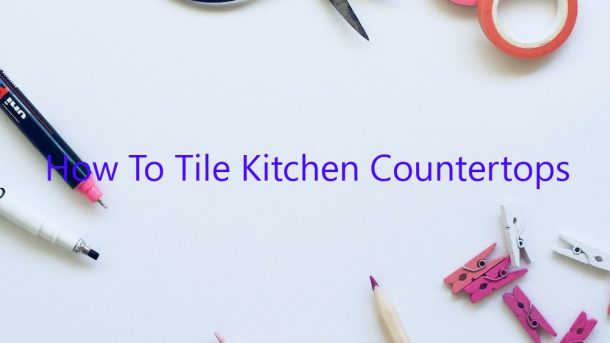Installing tile on kitchen countertops is a popular DIY project. It can be a challenge, but with the right tools and instructions, it can be a fun and rewarding project. Here are a few tips to help you get started.
1. Choose the right tile.
Not all tiles are created equal. Some tiles are better suited for kitchen countertops than others. Look for a tile that is durable and scratch resistant. Ceramic and porcelain tiles are good choices, but be sure to avoid glass tiles, which can be easily scratched.
2. Prepare the surface.
Before you can start tiling, you need to prepare the surface. If the countertops are old and outdated, you may need to remove the old finish before you can start tiling. If the countertops are in good condition, you can skip this step.
3. Measure and mark the surface.
Once the surface is prepared, you can start measuring and marking the surface. Be sure to measure and mark the surface accurately, so that the tiles will be evenly spaced.
4. Apply the adhesive.
Once the surface is marked, you can start applying the adhesive. Be sure to follow the manufacturer’s instructions closely.
5. Install the tiles.
Once the adhesive is dry, you can start installing the tiles. Be sure to press each tile firmly into place to ensure a good bond.
6. Let the adhesive dry.
Once the tiles are installed, you need to let the adhesive dry. This can take several hours, so be patient.
7. Seal the tiles.
Once the adhesive is dry, you can seal the tiles with a sealant of your choice. This will help protect the tiles from scratches and stains.
Contents
Can you tile over existing kitchen countertops?
There are a few factors to consider before tiling over existing kitchen countertops. The most important is the condition of the countertops. If they are in good condition and sturdy, then tiling over them is a viable option. However, if they are in poor condition or not sturdy enough to support the weight of tiles, then it is not recommended to tile over them.
Another factor to consider is the type of countertops. If the countertops are made of a porous material, such as wood or concrete, then tiling over them will not be as effective at preventing moisture absorption. Tiles can also be difficult to clean if they are installed over a porous surface.
If the existing countertops are in good condition and are made of a non-porous material, then tiling over them is a good option. It is important to make sure that the existing countertops are clean and free of any debris or grease before installing the tiles. Tiles can be easily cleaned with a damp cloth, making them a good choice for a kitchen countertop.
What kind of tile do you use for kitchen countertops?
There are many types of tile you can use for kitchen countertops, but the most popular type is ceramic tile. Ceramic tiles are available in a wide variety of colors and styles, and they are very durable. They are also easy to clean and maintain.
Another popular type of tile for kitchen countertops is granite tile. Granite is a natural stone that is very durable and resistant to stains and scratches. It is also heat-resistant, so it is a good choice for kitchens.
If you are looking for a more unique option, you could consider using glass tile for your kitchen countertops. Glass tiles come in a variety of colors and styles, and they are very durable. They are also easy to clean and maintain.
No matter what type of tile you choose for your kitchen countertops, be sure to select a tile that is rated for countertops. This will ensure that your tile is durable and resistant to scratches and staining.
Can you put tile on top of laminate countertops?
Can you put tile on top of laminate countertops?
Yes, you can put tile on top of laminate countertops. However, you need to make sure that the laminate is in good condition and that it is properly sealed. You should also use a thinset mortar and a backerboard to attach the tile to the countertop.
What goes under tile countertops?
Tile countertops are a popular choice for kitchens and bathrooms, as they are durable and easy to clean. However, before installing tile countertops, it is important to know what goes under them.
The most common materials that go under tile countertops are backerboard and mortar. Backerboard is a water-resistant, fiber-cement board that is used to provide a solid surface for tile installation. Mortar is a mixture of cement, sand, and water that is used to adhere tile to a surface.
Another option for what goes under tile countertops is plywood. Plywood is a panel made of thin sheets of wood that are glued together. It is a less common choice than backerboard or mortar, but it can be a good option for areas that are not exposed to a lot of moisture, such as a laundry room.
Whatever material is chosen to go under tile countertops, it is important to make sure that it is installed correctly. Improper installation can lead to problems with the countertops down the road.
How do you finish the edges of a tile countertop?
Tile countertops are a popular choice for many homeowners because they are durable and easy to clean. However, one of the drawbacks of a tile countertop is the sharp edges of the tiles. In order to finish the edges of a tile countertop and make them safe to use, you will need to follow a few steps.
The first step is to determine the edge treatment that you want for your countertop. There are many different options available, including beveled, bullnosed, and ogee edges. Once you have chosen an edge treatment, you will need to measure the edge of the countertop and mark the measurements on the tiles.
Then, use a wet saw to cut the tiles to the correct size. Be sure to wear safety goggles and a respirator when using a wet saw, as the sawdust can be harmful to your lungs.
After the tiles have been cut, use a tile nipper to remove the sharp edges. Be careful not to damage the tiles while doing this.
Finally, use a sealant to protect the edges of the tiles from moisture and dirt.
Are tile countertops outdated?
Tile countertops have been a popular choice for kitchen countertops for many years. However, there is a growing trend of homeowners choosing other materials, such as granite or quartz, instead of tile. So, are tile countertops outdated?
There are a few reasons why tile countertops may be seen as outdated. Firstly, they are more difficult to maintain than other materials. They require regular sealing and polishing to keep them looking their best. Secondly, they can be quite cold in the winter months. And finally, they are not as durable as other materials and can chip and crack easily.
However, there are also a few reasons why tile countertops may still be a good choice for your kitchen. Firstly, they are very affordable compared to other materials. Secondly, they are very easy to clean – just a quick wipe with a damp cloth will do the trick. And finally, they are very heat resistant, which is a plus if you like to cook on your countertops.
So, overall, it really depends on your needs and wants as to whether tile countertops are outdated. If you are looking for a low-maintenance, affordable option that is heat resistant, then they may still be a good choice for you. But if you are looking for a more luxurious, high-end look, then you may want to consider other materials.
How do you stick tile to laminate?
If you’re looking to update your home with some new tile flooring, you may be wondering how to stick the tile to your existing laminate flooring. It’s actually a pretty simple process, but there are a few things you need to know to do it correctly.
The first thing you’ll need is a tile adhesive. You can find this at any hardware store. Be sure to read the instructions on the adhesive carefully, as each brand varies.
Once you have the adhesive, you’ll need to clean the surface of the laminate flooring where you’ll be sticking the tile. This is important, as any dirt or dust on the surface will prevent the adhesive from sticking properly.
Once the surface is clean, you can begin to apply the adhesive. Be sure to spread it evenly, and make sure that the tiles are properly aligned before pressing them into the adhesive.
Once the tiles are in place, you’ll need to wait 24 hours for the adhesive to dry completely. After that, you can start to grout the tiles.
If you’re not sure how to grout tiles, there are plenty of tutorials online. Just be sure to read the instructions carefully, as grouting can be a tricky process.
If you follow these steps, you’ll be able to successfully stick tile to your laminate flooring.




